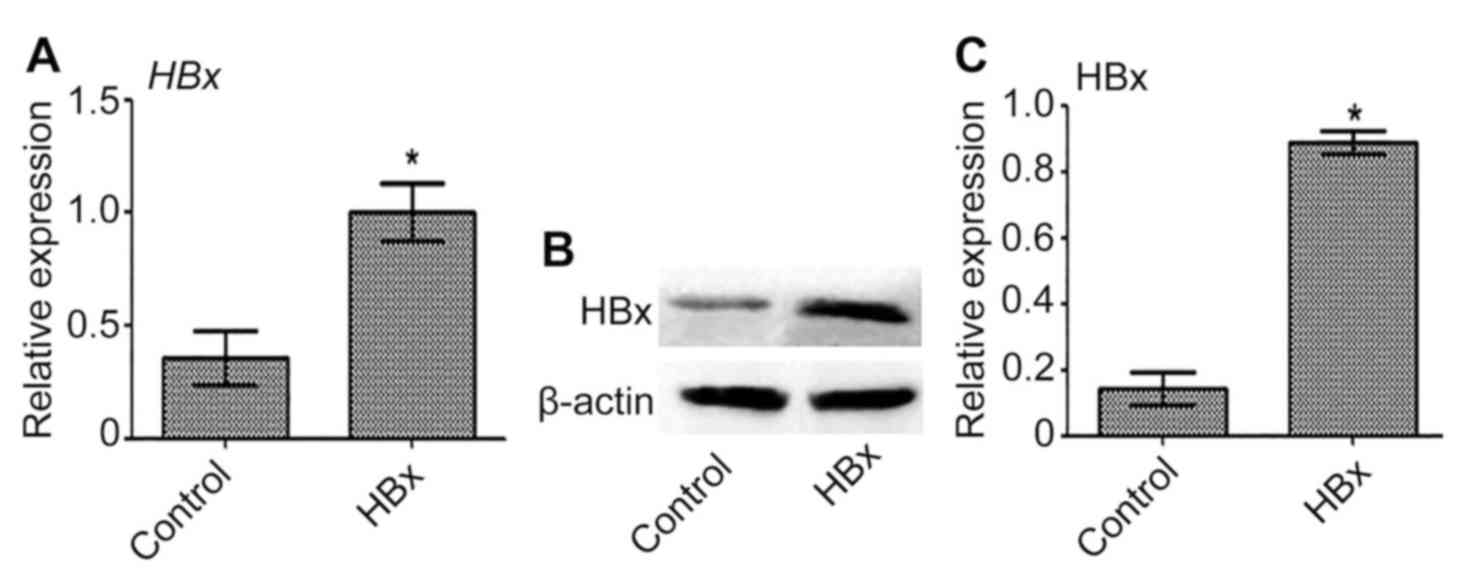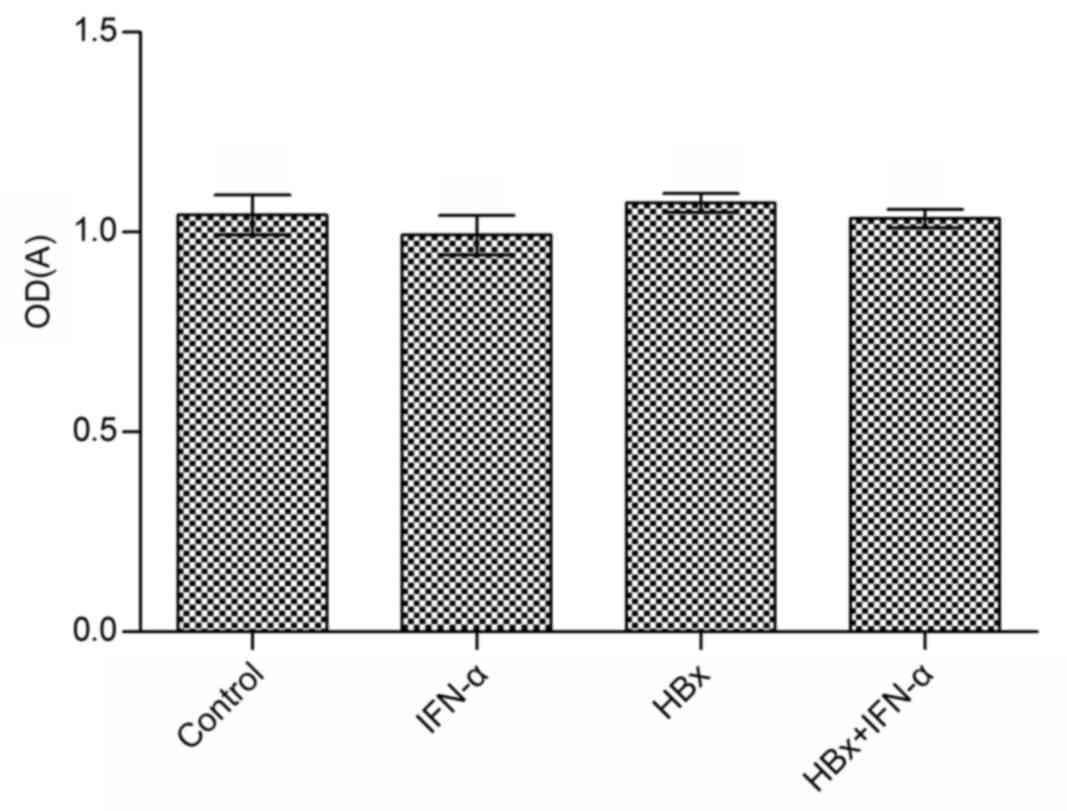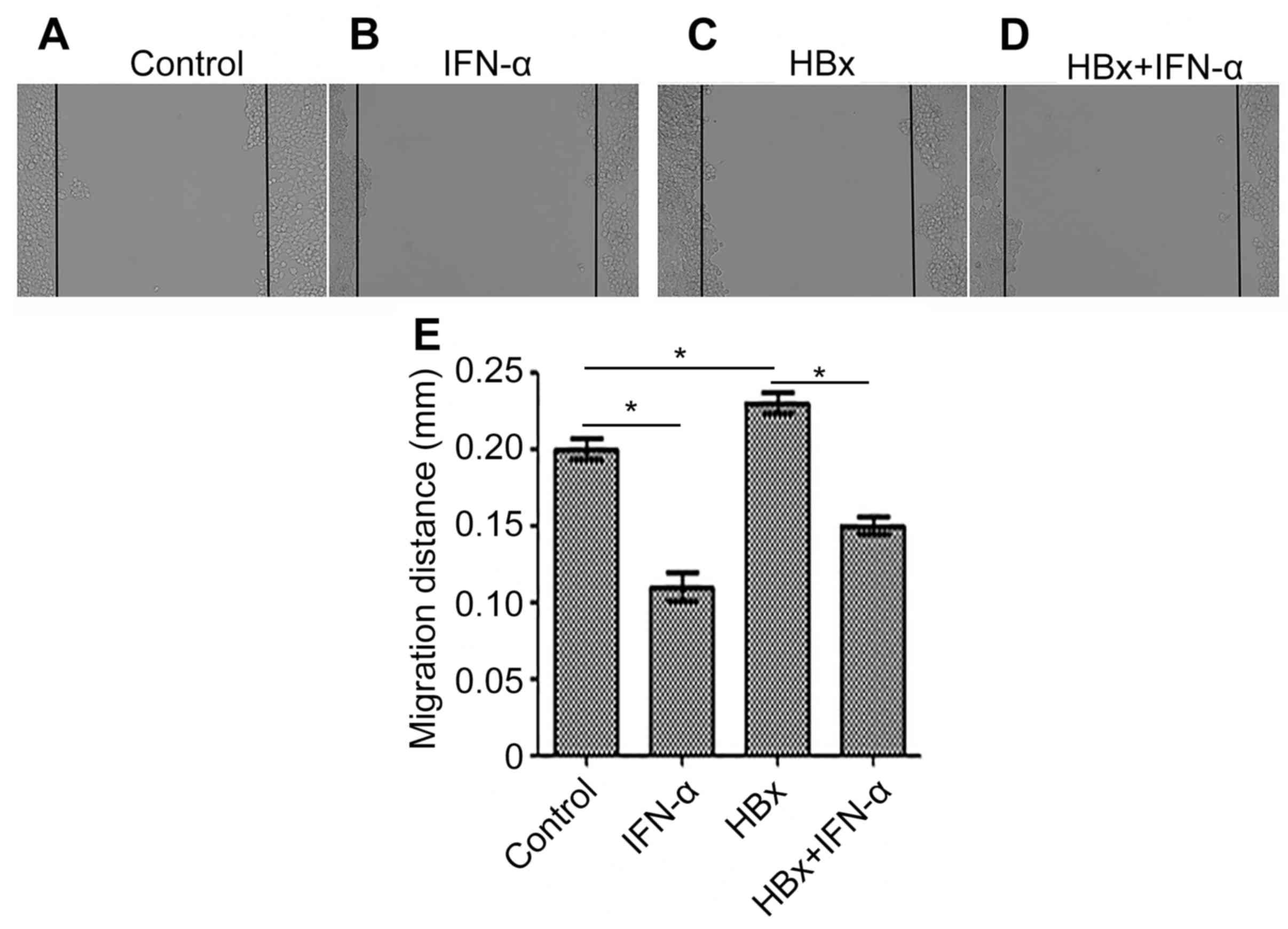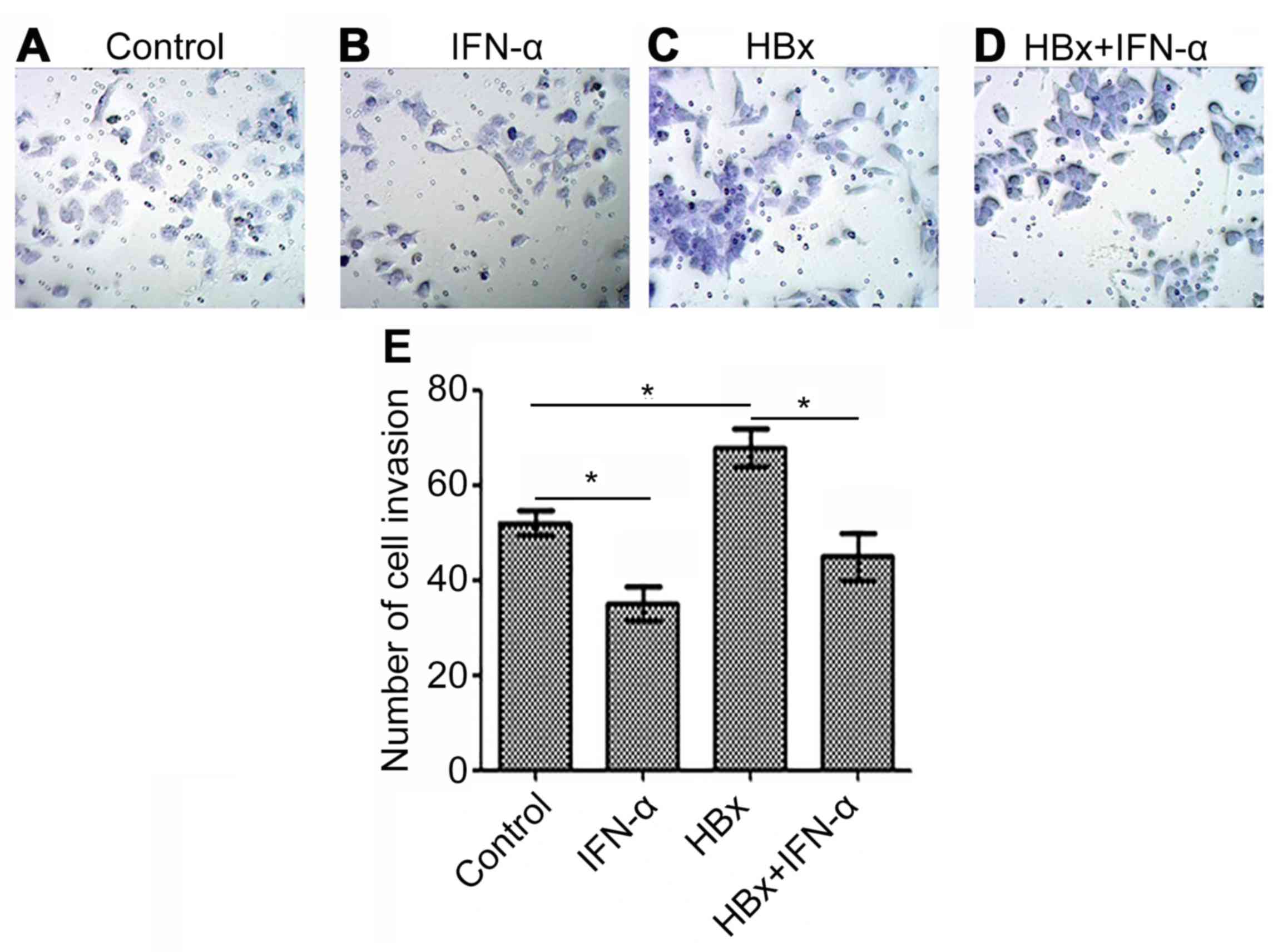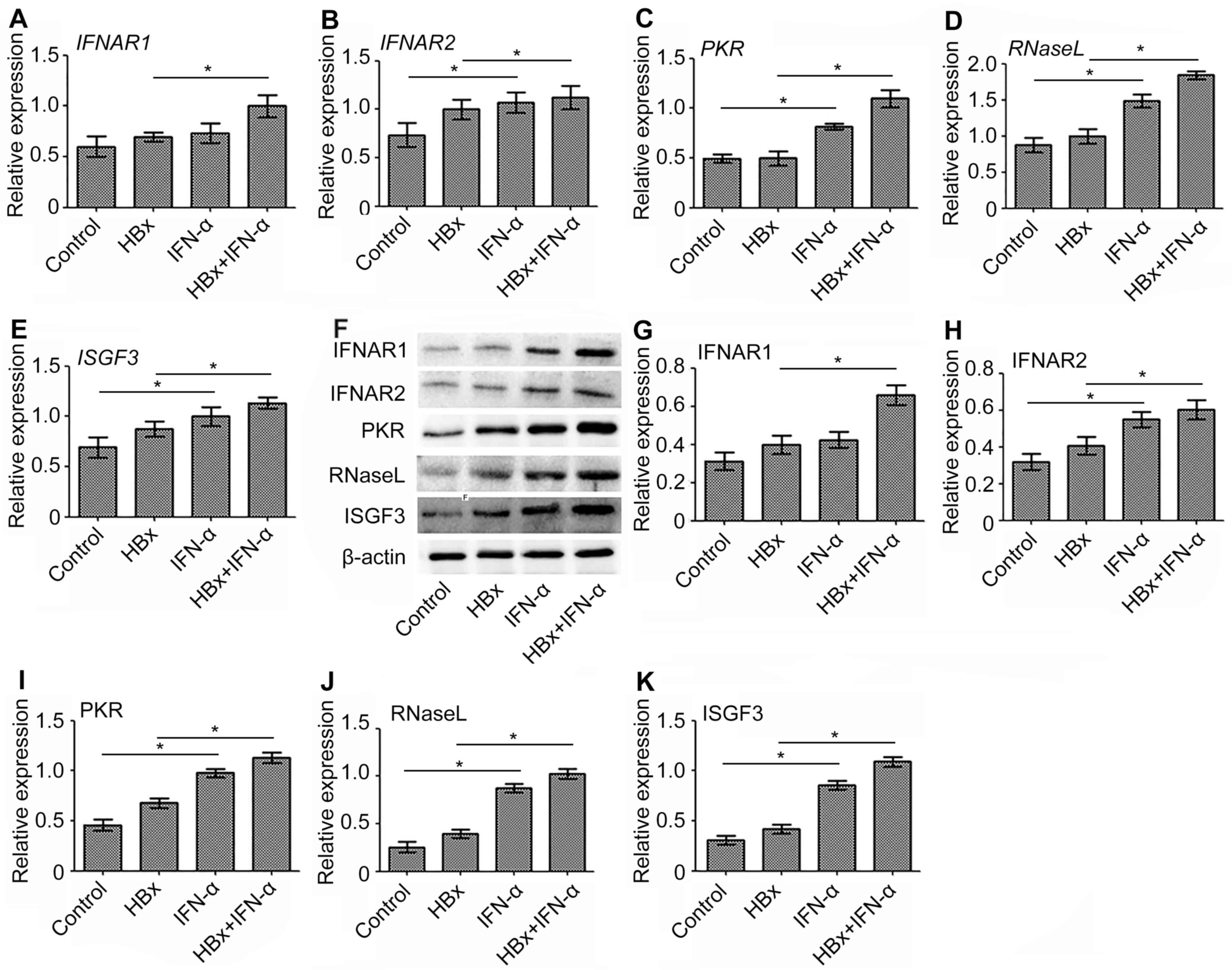Interferon‑α inhibits cell migration and invasion and induces the expression of antiviral proteins in Huh‑7 cells transfected with hepatitis B virus X gene‑expressing lentivirus
- Authors:
- Published online on: October 11, 2017 https://doi.org/10.3892/etm.2017.5288
- Pages: 5924-5930
-
Copyright: © Yang et al. This is an open access article distributed under the terms of Creative Commons Attribution License.
Abstract
Introduction
Hepatitis B virus (HBV) is an infectious disease that poses a serious threat to human health. It is demonstrated that sexual promiscuity, transfusion of unscreened blood, reusing or sharing of syringes between injection in drug users are the predominant associated risk factors (1,2). The World Health Organization estimates that there are ~350 million people worldwide infected with HBV, which may develop into chronic hepatitis B, liver fibrosis, liver sclerosis or liver cancer (3,4). The estimated worldwide mortality is 0.5 to 1.2 million fatalities a year (1). However, t here are currently no effective treatments for HBV-related liver cancer.
Interferon-α (IFN-α) is an antiviral cytokine that has a broad spectrum of action, exhibits high activity and indirect and species specificity (5,6). IFN-α exerts its antiviral activity via activation of the Janus kinase/signal transducer and activator of transcription (JAK-STAT) signaling pathway (7,8). In addition, IFN-α inhibits tumor development by decreasing cell viability, promoting cell apoptosis and attenuating tumor angiogenesis (9–11). IFN-α serves a role in immune surveillance and regulation by enhancing the immune function of T- and B-lymphocytes, natural killer cells and macrophages to enhance the body's ability to kill cancer cells and tumor cells infected by the virus (12,13). The effect of IFN-α on anti-viral, anti-tumor and immune regulation indicates that IFN-α may be used as to treat patients with HBV-related liver cancer. However, the role served by IFN-α regulation in the development of HBV-related liver cancer remains unknown.
Hepatitis B X protein (HBx), encoded by HBV DNA, serves an important role during the development of chronic hepatitis B, liver cirrhosis and liver cancer (14). Therefore, the current study established a novel HBV-related liver cancer model by transfecting the hepatoma cell line Huh-7 with HBx-expressing lentivirus, which has been previously studied (15–18) and subsequently investigated the effect of IFN-α on the growth of cancer cells to identify its potential as a drug for treating HBV-related liver cancer.
Materials and methods
Cell culture
The human hepatoma cell line Huh-7 (The Cell Bank of Type Culture Collection of Chinese Academy of Sciences; Wuhan, China) was cultured in Dulbecco's Modified Eagle medium (DMEM; HyClone; GE Healthcare Life Sciences, Logan, UT, USA) supplemented with 10% fetal bovine serum (Gibco; Thermo Fisher Scientific, Inc., Waltham, MA, USA), 80 U/ml penicillin and 80 µg/ml streptomycin (HyClone; GE Healthcare Life Sciences). The cells were incubated in 5% CO2 at 37°C. 1,000 IU/ml of IFN-α (Sigma-Aldrich; Merck KGaA; Darmstadt, Germany) was used to treat the cells in the following experiments.
Transfection of HBx-expressing lentivirus into Huh-7 cells
HBx-expressing lentivirus was produced from pLenti6.2/V5-DEST plasmid (Invitrogen; Thermo Fisher Scientific, Inc., Waltham, MA, USA) with the second generational system. Briefly, the packaging plasmids were transformed into 293T cells with Lipofectamine 2000 (Invitrogen; Thermo Fisher Scientific, Inc.) according to the manufacturer's protocol. Lentivirus was harvested 72 h after transfection, and then the titer was determined as described previously (19). Huh-7 cells were transfected with 3×107 infectious units per milliliter of HBx-expressing lentivirus (Novobio Scientific, Inc., Shanghai, China) on a 96-well plate. The control cells were transfected with the same concentration of empty lentivirus. Medium was replaced 24 h following transfection, and subsequent experiments began 24 h post transfection.
Treatment groups
The following four groups were used in the present study: Control (no treatment); IFN-α only, Huh-7 cells were treated with 1,000 IU/ml of IFN-α for 24 h at 37°C; HBx infected cells, Huh-7 cells were transfected with 3×107 infectious units per milliliter of HBx-expressing lentivirus for 24 h at 37°C; HBx+IFN-α group, after the transfection of HBx-expressing lentivirus for 24 h, Huh-7 cells were treated with 1,000 IU/ml of IFN-α for an additional 24 h.
Reverse transcription-quantitative polymerase chain reaction (RT-qPCR)
Cells were washed with cold PBS three times and harvested following centrifugation at 3,000 × g at 4°C for 5 min. Total RNA was extracted using RNAiso Plus (Takara Bio., Dalian, China) according to the manufacturer's instructions and subjected to electrophoresis on 1.5% native agarose gel for integrity and quality analysis. A total of 1 µg RNA was used for cDNA synthesis with a PrimeScript RT reagent kit (Takara Bio, Inc., Otsu, Japan) following the manufacturer's protocol. A total of 1 µl 20-fold-diluted cDNA was used as a template for qPCR, which was performed using the Bio-Rad Detection system and SYBR Green qPCR SuperMix (Invitrogen; Thermo Fisher Scientific, Inc.) following the manufacturer's protocol with the corresponding primers (Table I). PCR conditions consisted of: 95°C for 30 sec, followed by 40 cycles of 95°C for 5 sec and 60°C for 30 sec. Relative expression was determined following normalization to the reference gene GAPDH. RT-qPCR data were collected from three independent biological replicates and analyzed with the 2−ΔΔCT method (20).
Western blot analysis
Antibodies against β-actin (catalogue no., ab8227), IFN α and β receptor subunit 1 (IFNAR1) (catalogue no., ab45172), IFNAR2, interferon-stimulated gene factor 3 (ISGF3) (catalogue no., ab56070), double-stranded RNA-activated protein kinase R (PKR) (catalogue no., ab32506) and ribonuclease L (RNase L) (catalogue no., ab191392) were purchased from Abcam (Cambridge, UK). Cells were lysed with Cell lysis buffer (Beyotime Institute of Biotechnology, Shanghai, China) and centrifuged at 10,000 × g at 4°C for 15 min. Supernatant lysates were harvested and the concentration was determined by Bradford method with Bradford Protein Assay Kit (Beyotime Institute of Biotechnology, China). Subsequently, 30 µg of proteins were loaded per lane and subjected to 10% SDS-PAGE. Proteins in the gel were transferred to a nitrocellulose membrane and the membrane was blocked with 5% milk powder at 4°C overnight. Primary antibodies were diluted 1:1,000 in TBST buffer and incubated for 2 h at room temperature. Following incubation with primary antibodies, the membrane was washed three times with TBST. Horseradish peroxidase conjugated secondary antibody (anti-rabbit IgG) (catalogue no., ab6721; Abcam) was diluted 1:5,000 in 5% milk powder and incubated for 2 h at room temperature. The blotting membrane was then washed three times with TBST. Target bands were detected using ECL regents (Beyotime Institute of Biotechnology; catalogue no., P0018) and quantitatively analyzed using Quantity one software version 4.1 (Bio-Rad Laboratories, Inc., Hercules, CA, USA). β-actin was used as the reference gene.
Detection of cell viability using an MTT assay
Following transfection, a total of 1×105 Huh-7 cells/well were seeded in a 96-well plate and allowed to adhere and spread for 24 h. Huh-7 cells in the IFN-α alone and HBVx-expressing lentivirus + treatment with IFN-α groups were treated with IFN-α. A total of 10 µl MTT solution (5 mg/ml in PBS) was subsequently added to the cell medium of cells in all groups and incubated for 4 h at 37°C. The culture supernatant was subsequently removed, 100 µl dimethylsulphoxide was added and the solution was shaken for 10 min. Absorbance was measured at a wavelength of 490 nm.
Cell scratch test
A total of 1.6×105 Huh-7 cells were seeded in a 6-well plate and allowed to grow until 80% confluence was reached. A micropipette tip was used to gently scratch a line of cells off the plate. The cell plate was washed three times with PBS to remove any remaining scratched cells. Following treatment, cells were cultured for an additional 24 h in serum-free DMEM. Cell migration into the scratch site was measured using an inverted IX81 Olympus microscope (Olympus Corporation of the Americas; Center Valley, PA, USA) and ImageJ software version 1.41o (National Institute of Health; Bethesda, MD, USA).
Cell invasion test
A suspension of 0.5×106 cells was placed in each well of the lower chamber of a 24-well plate. Cells were cultured in DMEM containing 10% fetal bovine serum. The upper chamber Matrigel culture insert was then placed on top of the lower chamber. A total of 1×105 of cells were added on top of the Transwell membrane in the upper chamber, cultured in serum free DMEM. Invasion chambers were incubated for 48 h in 5% CO2 at 37°C. Following incubation, noninvasive cells were removed by scraping the upper surface of the Matrigel membrane using a cotton swab. Invading cells on the lower surface of the membrane were fixed with 4% paraformaldehyde for 15 min at room temperature, washed with PBS and stained with Giemsa solution for 10 min at room temperature. The stained membrane was photographed using an inverted IX81 Olympus microscope (Olympus Corporation of the Americas) and the number of cells was counted.
Statistical analysis
Data are expressed as the mean ± standard deviation based on three independent biological replicates. Statistical analysis was performed using SPSS 19.0 (IBM Corp., Armonk, NY, USA). Student's t-test was used to conduct a pairwise comparison. Multiple comparisons were tested using one-way analysis of variance, followed by a Tukey honest significant difference test. P<0.05 was determined to indicate statistically significant difference.
Results
Transfection of Huh-7 cells with HBx-expressing lentivirus
Transfection of Huh-7 cells with HBx-expressing lentivirus was performed to establish a novel HBV-related liver cancer model (Huh-7-HBx). The expression of HBx mRNA and protein in Huh-7-HBx cells was significantly upregulated compared with the control (P<0.05; Fig. 1). Therefore, HBx was successfully overexpressed in Huh-7 cells.
Cell viability is not affected by the transfection of Huh-7 cells with HBx-expressing lentivirus or by treatment with IFN-α
Huh-7 cell viability was measured using an MTT assay following the transfection of Huh-7 cells with HBx-expressing lentivirus and IFN-α treatment. The effect of IFN-α treatment alone on Huh-7 cell viability compared with the control group was not significant (Fig. 2). Similarly, the difference in cell viability in the Huh-7-HBx and Huh-7-HBx+IFN-α treatment groups compared with the control was not significant. IFN-α treatment only slightly inhibited the viability of Huh-7-HBx cells. These results suggest that IFN-α does not affect cell viability in HBV-related liver cancer.
IFN-α inhibits HBx-induced cell migration in Huh-7 cells
Migration is an important characteristic of cancer cells; therefore cell migration was examined in the Huh-7-HBx and Huh-7-HBx+IFN-α treatment groups to determine the curative function of IFN-α in HBV-related liver cancer (Fig. 3). Cell migration was decreased (P<0.05) in the IFN-α treatment alone group (Fig. 3B) and increased (P<0.05) in the Huh-7-HBx group (Fig. 3C) compared with the control (Fig. 3A). There was a decrease (P<0.05) in cell migration in the Huh-7-HBx+IFN-α treatment group (Fig. 3D) compared with the control, but not to the same extent as the decrease observed in the IFN-α treatment alone group. Quantitative analysis of cell migration in each of the groups supported these observations (Fig. 3E). This suggests that IFN-α may inhibit cell migration in HBV-related liver cancer.
IFN-α inhibits HBx-induced Huh-7 cell invasion
Cell invasion indicates tumor carcinogenesis, thus the HBx-regulated liver cancer model was used to determine the curative function of IFN-α in HBV-related liver cancer (Fig. 4). Huh-7 cell invasion was decreased (P<0.05) in the IFN-α treatment alone group (Fig. 4B) and increased (P<0.05) in the Huh-7-HBx group (Fig. 4C) compared with the control (Fig. 4A). There was a decrease (P<0.05) in cell invasion in the Huh-7-HBx+IFN-α treatment group (Fig. 4D) compared with the control, but not to the same extent as the decrease observed in the IFN-α treatment alone group. Quantitative analysis of cell invasion was consistent with these results (Fig. 4E). This indicates that IFN-α may reduce cell invasion in HBV-related liver cancer.
IFN-α promotes the expression of antiviral genes during transcription and translation in Huh-7-HBx cells
IFNAR1, IFNAR2, ISGF3, PKR and RNase L are important antiviral genes that exhibit anti-HBV effects (21–25). Therefore, the expression of the antiviral genes was examined in a HBx-regulated liver cancer model to determine the curative function of IFN-α in HBV-related liver cancer. RT-qPCR demonstrated that the expression of IFNAR1 (Fig. 5A), IFNAR2 (Fig. 5B), PKR (Fig. 5C), RNaseL (Fig. 5D) and ISGF3 (Fig. 5E) mRNA was significantly increased (P<0.05) in the IFN-α treatment only group compared to the control. mRNA levels of these antiviral genes were upregulated (P<0.05) in the Huh-7-HBx group compared with the control group however, not to the extent of the increase demonstrated in the IFN-α treatment only group. The most significant increase in expression of antiviral gene mRNA, compared with the control, was in the Huh-7-HBx+IFN-α treatment group. The protein expression of these antiviral genes was consistent with this (Fig. 5F-K). These results suggest that IFN-α increases the mRNA and protein levels of antiviral genes in HBV-related liver cancer.
Discussion
HBV infection is a major cause of primary liver cancer (12,26). The present study demonstrated that the transfection of Huh-7 cells with HBx, a protein encoded by HBV DNA, had no effect on cell viability but promoted cell migration and invasion, which is consistent with the results of a previous study (27).
IFN-α is currently used as a first-line antiviral drug to treat chronic hepatitis B (CHB) (28,29). It is an effective treatment of HBV due to its antiviral function and immunomodulatory effects (30–34). IFN-α does not directly kill or inhibit HBV; however, its antiviral effect is facilitated by its binding to the cell membrane receptor IFNAR1, which leads to the production of antiviral proteins that inhibit HBV replication (35,36). Therefore, IFNAR1 serves a role in the progression of CHB. The binding of IFN-α to its receptor IFNAR1 activates Janus kinase-JAK1 and non-receptor tyrosine-protein kinase TYK2, which leads to the phosphorylation of signal transducer and activator of transcription (STAT) 1 and STAT2 (37,38). STAT1 and STAT2 then form a heterodimer and bind to interferon regulatory factor 9 (IRF-9) to form ISGF3. ISGF3 translocates from the cytoplasm to the nucleus and binds to the IFN stimulated regulatory element to promote the transcription of antiviral genes, such as PKR (39–41). Previous studies have demonstrated that following treatment with IFN-α, the expression of STAT2, IRF-9, and PKR is significantly increased in HepG2 and HepG2.2.15 cells (42,43). There was also a decrease in HBV DNA titer in HepG2.2.15 cells, which suggests that the JAK-STAT pathway serves a major role in IFN-α-inhibited HBV replication. Furthermore, the expression of ISGF3 protein and PKR mRNA was significantly decreased following inhibition of the IFN pathway and the titer of HBV DNA in the supernatant of HepG2.2.15 cells was not significantly decreased. These results indicate that ISGF3 is an important regulatory factor of the pathway (25,44).
IFN-α activates the JAK-STAT signaling pathway by binding to IFNARs on the cell surface, thereby facilitating the transcription and expression of antiviral genes, including PKR (45) and RNaseL (46). The present study demonstrated that IFN-α significantly increases the expression of the antiviral genes IFNAR1, IFNAR2, PKR, RNaseL and ISGF3 in Huh-7 cells transfected with HBx-expressing lentivirus, suggesting that IFN-α may be developed as a novel therapeutic strategy to treat patients with HBV-related liver cancer.
In conclusion, the current study suggests that IFN-α attenuates the development of HBV-related liver cancer by reducing cell migration and invasion, as well as upregulating the expression of antiviral proteins.
Acknowledgements
The present study was supported by the Specific Fund of Clinical Medical Research of the Chinese Medical Association (grant no. 14040350572; Beijing, China).
References
|
Lavanchy D: Hepatitis B virus epidemiology, disease burden, treatment, and current and emerging prevention and control measures. J Viral Hepat. 11:97–107. 2004. View Article : Google Scholar : PubMed/NCBI | |
|
Liaw YF and Chu CM: Hepatitis B virus infection. Lancet. 373:582–592. 2009. View Article : Google Scholar : PubMed/NCBI | |
|
Hooshyar A, Habibzadeh S, Ghasemi N, Yazdanbod A, Sohrabi S, Maleki N and Amani F: Females have a lower liver histopathological score in HBeAg-negative chronic hepatitis B than males. Arch Clin Infect Dis. 8:e179722013. View Article : Google Scholar | |
|
Yang N and Bertoletti A: Advances in therapeutics for chronic hepatitis B. Hepatol Int. 10:277–285. 2016. View Article : Google Scholar : PubMed/NCBI | |
|
Chen J, Zhao J, Chen L, Dong N, Ying Z, Cai Z, Ji D, Zhang Y, Dong L, Li Y, et al: STAT1 modification improves therapeutic effects of interferons on lung cancer cells. J Transl Med. 13:2932015. View Article : Google Scholar : PubMed/NCBI | |
|
Gerber SA, Yatsula B, Maier CL, Sadler TJ, Whittaker LW and Pober JS: Interferon-gamma induces prolyl hydroxylase (PHD)3 through a STAT1-dependent mechanism in human endothelial cells. Arterioscler Thromb Vasc Biol. 29:1363–1369. 2009. View Article : Google Scholar : PubMed/NCBI | |
|
Rehermann B and Bertoletti A: Immunological aspects of antiviral therapy of chronic hepatitis B virus and hepatitis C virus infections. Hepatology. 61:712–721. 2015. View Article : Google Scholar : PubMed/NCBI | |
|
Bowick GC, Airo AM and Bente DA: Expression of interferon-induced antiviral genes is delayed in a STAT1 knockout mouse model of Crimean-Congo hemorrhagic fever. Virol J. 9:1222012. View Article : Google Scholar : PubMed/NCBI | |
|
von Marschall Z, Scholz A, Cramer T, Schäfer G, Schirner M, Oberg K, Wiedenmann B, Höcker M and Rosewicz S: Effects of interferon alpha on vascular endothelial growth factor gene transcription and tumor angiogenesis. J Natl Cancer Inst. 95:437–448. 2003. View Article : Google Scholar : PubMed/NCBI | |
|
Fazio N and Oberg K: Prospective, randomized, multicenter trial on the antiproliferative effect of lanreotide, interferon alfa and their combination for therapy of metastatic neuroendocrine gastroenteropancreatic tumors. J Clin Oncol. 22:573–575. 2004. View Article : Google Scholar : PubMed/NCBI | |
|
De Palma M, Mazzieri R, Politi LS, Pucci F, Zonari E, Sitia G, Mazzoleni S, Moi D, Venneri MA, Indraccolo S, et al: Tumor-targeted interferon-alpha delivery by Tie2-expressing monocytes inhibits tumor growth and metastasis. Cancer Cell. 14:299–311. 2008. View Article : Google Scholar : PubMed/NCBI | |
|
Kim JY, Song EH, Lee HJ, Oh YK, Choi KH, Yu DY, Park SI, Seong JK and Kim WH: HBx-induced hepatic steatosis and apoptosis are regulated by TNFR1- and NF-kappaB-dependent pathways. J Mol Biol. 397:917–931. 2010. View Article : Google Scholar : PubMed/NCBI | |
|
Wang HY, Yang SL, Liang HF and Li CH: HBx protein promotes oval cell proliferation by up-regulation of cyclin D1 via activation of the MEK/ERK and PI3K/Akt pathways. Int J Mol Sci. 15:3507–3518. 2014. View Article : Google Scholar : PubMed/NCBI | |
|
Murakami S: Hepatitis B virus X protein: A multifunctional viral regulator. J Gastroenterol. 36:651–660. 2001. View Article : Google Scholar : PubMed/NCBI | |
|
Kim CM, Koike K, Saito I, Miyamura T and Jay G: HBx gene of hepatitis B virus induces liver cancer in transgenic mice. Nature. 351:317–320. 1991. View Article : Google Scholar : PubMed/NCBI | |
|
Lara-Pezzi E, Gomez-Gaviro MV, Galvez BG, Mira E, Iñiguez MA, Fresno M, Martínez AC, Arroyo AG and López-Cabrera M: The hepatitis B virus X protein promotes tumor cell invasion by inducing membrane-type matrix metalloproteinase-1 and cyclooxygenase-2 expression. J Clin Invest. 110:1831–1838. 2002. View Article : Google Scholar : PubMed/NCBI | |
|
Tanaka Y, Kanai F, Kawakami T, Tateishi K, Ijichi H, Kawabe T, Arakawa Y, Kawakami T, Nishimura T, Shirakata Y, et al: Interaction of the hepatitis B virus X protein (HBx) with heat shock protein 60 enhances HBx-mediated apoptosis. Biochem Biophys Res Commun. 318:461–469. 2004. View Article : Google Scholar : PubMed/NCBI | |
|
Zhang X, Liu S, Hu T, Liu S, He Y and Sun S: Up-regulated microRNA-143 transcribed by nuclear factor kappa B enhances hepatocarcinoma metastasis by repressing fibronectin expression. Hepatology. 50:490–499. 2009. View Article : Google Scholar : PubMed/NCBI | |
|
Lizee G, Aerts JL, Gonzales MI, Chinnasamy N, Morgan RA and Topalian SL: Real-time quantitative reverse transcriptase-polymerase chain reaction as a method for determining lentiviral vector titers and measuring transgene expression. Hum Gene Ther. 14:497–507. 2003. View Article : Google Scholar : PubMed/NCBI | |
|
Livak KJ and Schmittgen TD: Analysis of relative gene expression data using real-time quantitative PCR and the 2(-Delta Delta C(T)) method. Methods. 25:402–408. 2001. View Article : Google Scholar : PubMed/NCBI | |
|
Frodsham AJ, Zhang L, Dumpis U, Taib NA, Best S, Durham A, Hennig BJ, Hellier S, Knapp S, Wright M, et al: Class II cytokine receptor gene cluster is a major locus for hepatitis B persistence. Proc Natl Acad Sci USA. 103:pp. 9148–9153. 2006, View Article : Google Scholar : PubMed/NCBI | |
|
Zhou J, Smith DK, Lu L, Poon VK, Ng F, Chen DQ, Huang JD, Yuen KY, Cao KY and Zheng BJ: A non-synonymous single nucleotide polymorphism in IFNAR1 affects susceptibility to chronic hepatitis B virus infection. J Viral Hepat. 16:45–52. 2009. View Article : Google Scholar : PubMed/NCBI | |
|
Han Q, Zhang C, Zhang J and Tian Z: Involvement of activation of PKR in HBx-siRNA-mediated innate immune effects on HBV inhibition. PLoS One. 6:e279312011. View Article : Google Scholar : PubMed/NCBI | |
|
Park IH, Kwon YC, Ryu WS and Ahn BY: Inhibition of hepatitis B virus replication by ligand-mediated activation of RNase L. Antiviral Res. 104:118–127. 2014. View Article : Google Scholar : PubMed/NCBI | |
|
Zhang Q, Wang Y, Wei L, Jiang D, Wang JH, Rao HY, Zhu L, Chen HS, Fei R and Cong X: Role of ISGF3 in modulating the anti-hepatitis B virus activity of interferon-alpha in vitro. J Gastroenterol Hepatol. 23:1747–1761. 2008. View Article : Google Scholar : PubMed/NCBI | |
|
Perz JF, Armstrong GL, Farrington LA, Hutin YJ and Bell BP: The contributions of hepatitis B virus and hepatitis C virus infections to cirrhosis and primary liver cancer worldwide. J Hepatol. 45:529–538. 2006. View Article : Google Scholar : PubMed/NCBI | |
|
Kong J, Kong F, Gao J, Zhang Q, Dong S, Gu F, Ke S, Pan B, Shen Q, Sun H, et al: YC-1 enhances the anti-tumor activity of sorafenib through inhibition of signal transducer and activator of transcription 3 (STAT3) in hepatocellular carcinoma. Mol Cancer. 13:72014. View Article : Google Scholar : PubMed/NCBI | |
|
Terrault NA, Bzowej NH, Chang KM, Hwang JP, Jonas MM and Murad MH: American Association for the Study of Liver Diseases: AASLD guidelines for treatment of chronic hepatitis B. Hepatology. 63:261–283. 2016. View Article : Google Scholar : PubMed/NCBI | |
|
Yuen MF, Ahn SH, Chen DS, Chen PJ, Dusheiko GM, Hou JL, Maddrey WC, Mizokami M, Seto WK, Zoulim F, et al: Chronic hepatitis b virus infection: Disease revisit and management recommendations. J Clin Gastroenterol. 50:286–294. 2016. View Article : Google Scholar : PubMed/NCBI | |
|
Belloni L, Allweiss L, Guerrieri F, Pediconi N, Volz T, Pollicino T, Petersen J, Raimondo G, Dandri M and Levrero M: IFN-α inhibits HBV transcription and replication in cell culture and in humanized mice by targeting the epigenetic regulation of the nuclear cccDNA minichromosome. J Clin Invest. 122:529–537. 2012. View Article : Google Scholar : PubMed/NCBI | |
|
Lai CL and Yuen MF: Prevention of hepatitis B virus-related hepatocellular carcinoma with antiviral therapy. Hepatology. 57:399–408. 2013. View Article : Google Scholar : PubMed/NCBI | |
|
Robek MD, Boyd BS and Chisari FV: Lambda interferon inhibits hepatitis B and C virus replication. J Virol. 79:3851–3854. 2005. View Article : Google Scholar : PubMed/NCBI | |
|
Piratvisuth T: Reviews for APASL guidelines: Immunomodulator therapy of chronic hepatitis B. Hepatol Int. 2:140–146. 2008. View Article : Google Scholar : PubMed/NCBI | |
|
Sprengers D and Janssen HL: Immunomodulatory therapy for chronic hepatitis B virus infection. Fundam Clin Pharmacol. 19:17–26. 2005. View Article : Google Scholar : PubMed/NCBI | |
|
Uzé G, Di Marco S, Mouchel-Vielh E, Monneron D, Bandu MT, Horisberger MA, Dorques A, Lutfalla G and Mogensen KE: Domains of interaction between alpha interferon and its receptor components. J Mol Biol. 243:245–257. 1994. View Article : Google Scholar : PubMed/NCBI | |
|
Peltekian C, Gordien E, Garreau F, Meas-Yedid V, Soussan P, Willams V, Chaix ML, Olivo-Marin JC, Bréchot C and Kremsdorf D: Human MxA protein participates to the interferon-related inhibition of hepatitis B virus replication in female transgenic mice. J Hepatol. 43:965–972. 2005. View Article : Google Scholar : PubMed/NCBI | |
|
Su L and David M: Distinct mechanisms of STAT phosphorylation via the interferon-alpha/beta receptor. Selective inhibition of STAT3 and STAT5 by piceatannol. J Biol Chem. 275:12661–12666. 2000. View Article : Google Scholar : PubMed/NCBI | |
|
Rani MR, Leaman DW, Han Y, Leung S, Croze E, Fish EN, Wolfman A and Ransohoff RM: Catalytically active TYK2 is essential for interferon-beta-mediated phosphorylation of STAT3 and interferon-alpha receptor-1 (IFNAR-1) but not for activation of phosphoinositol 3-kinase. J Biol Chem. 274:32507–32511. 1999. View Article : Google Scholar : PubMed/NCBI | |
|
Ward SV and Samuel CE: The PKR kinase promoter binds both Sp1 and Sp3, but only Sp3 functions as part of the interferon-inducible complex with ISGF-3 proteins. Virology. 313:553–566. 2003. View Article : Google Scholar : PubMed/NCBI | |
|
George CX, Das S and Samuel CE: Organization of the mouse RNA-specific adenosine deaminase Adar1 gene 5′-region and demonstration of STAT1-independent, STAT2-dependent transcriptional activation by interferon. Virology. 380:338–343. 2008. View Article : Google Scholar : PubMed/NCBI | |
|
Goh KC, Haque SJ and Williams BR: p38 MAP kinase is required for STAT1 serine phosphorylation and transcriptional activation induced by interferons. EMBO J. 18:5601–5608. 1999. View Article : Google Scholar : PubMed/NCBI | |
|
Yang X and Chan C: Repression of PKR mediates palmitate-induced apoptosis in HepG2 cells through regulation of Bcl-2. Cell Res. 19:469–486. 2009. View Article : Google Scholar : PubMed/NCBI | |
|
Chai Y, Huang HL, Hu DJ, Luo X, Tao QS, Zhang XL and Zhang SQ: IL-29 and IFN-α regulate the expression of MxA, 2′,5′-OAS and PKR genes in association with the activation of Raf-MEK-ERK and PI3K-AKT signal pathways in HepG2.2.15 cells. Mol Biol Rep. 38:139–143. 2011. View Article : Google Scholar : PubMed/NCBI | |
|
Guan SH, Lu M, Grünewald P, Roggendorf M, Gerken G and Schlaak JF: Interferon-alpha response in chronic hepatitis B-transfected HepG2.2.15 cells is partially restored by lamivudine treatment. World J Gastroenterol. 13:228–235. 2007. View Article : Google Scholar : PubMed/NCBI | |
|
Mathews JD, McCaw CT, McVernon J, McBryde ES and McCaw JM: A biological model for influenza transmission: Pandemic planning implications of asymptomatic infection and immunity. PLoS One. 2:e12202007. View Article : Google Scholar : PubMed/NCBI | |
|
Ren S, Yu H, Zhang H, Liu Y, Huang Y, Ma L, Wei L, Wu H and Chen XY: Polymorphisms of interferon-inducible genes OAS associated with interferon-α treatment response in chronic HBV infection. Antiviral Res. 89:232–237. 2011. View Article : Google Scholar : PubMed/NCBI |



